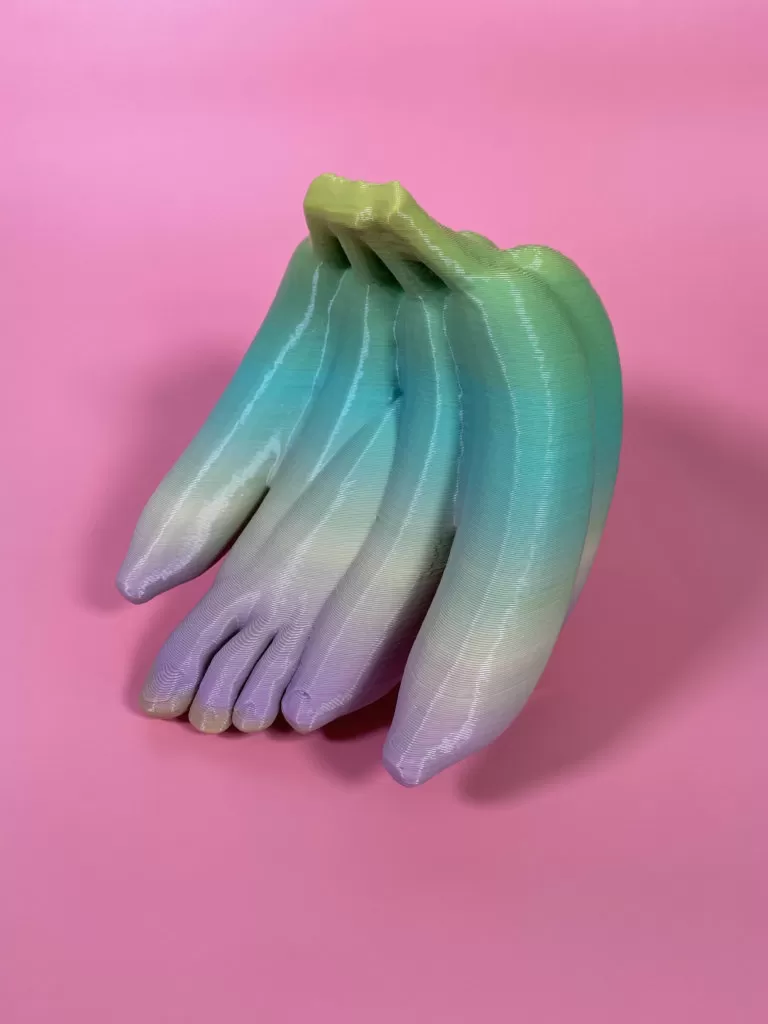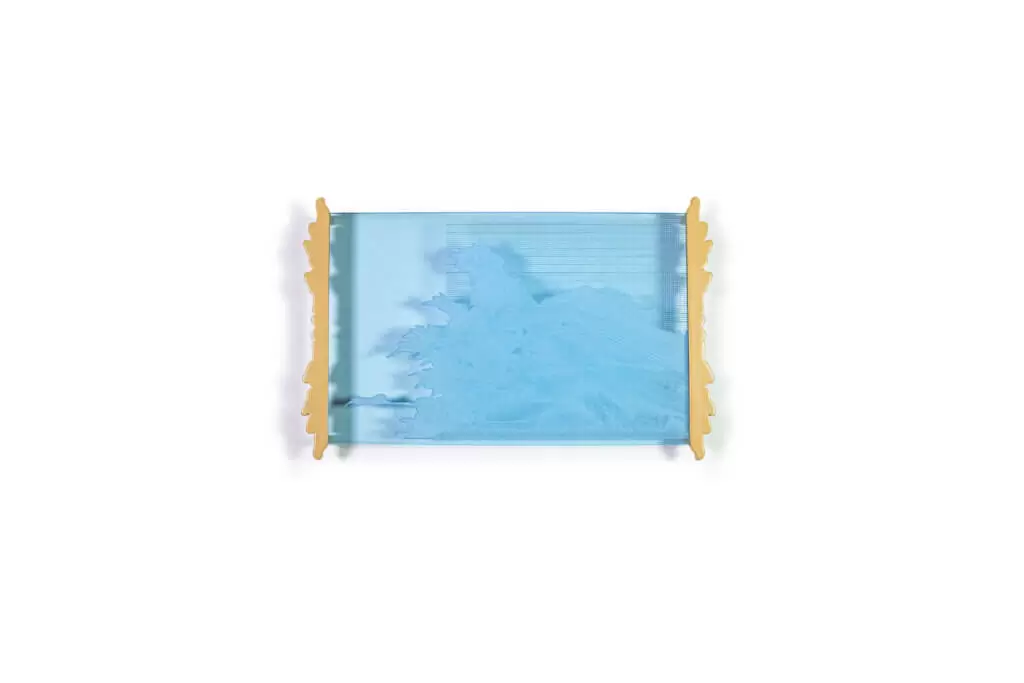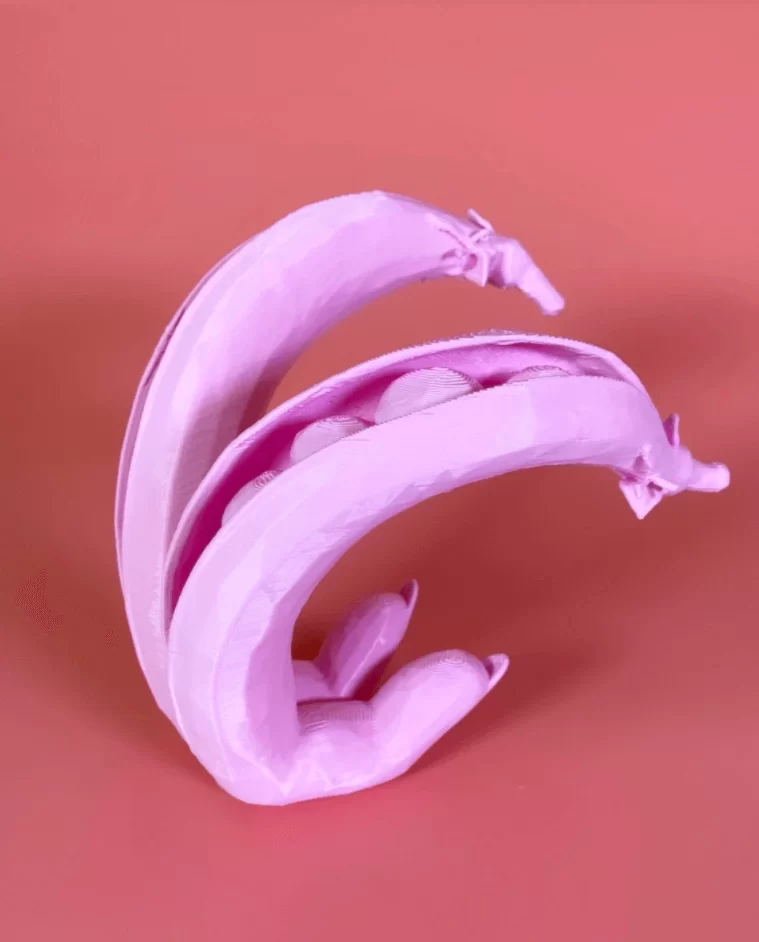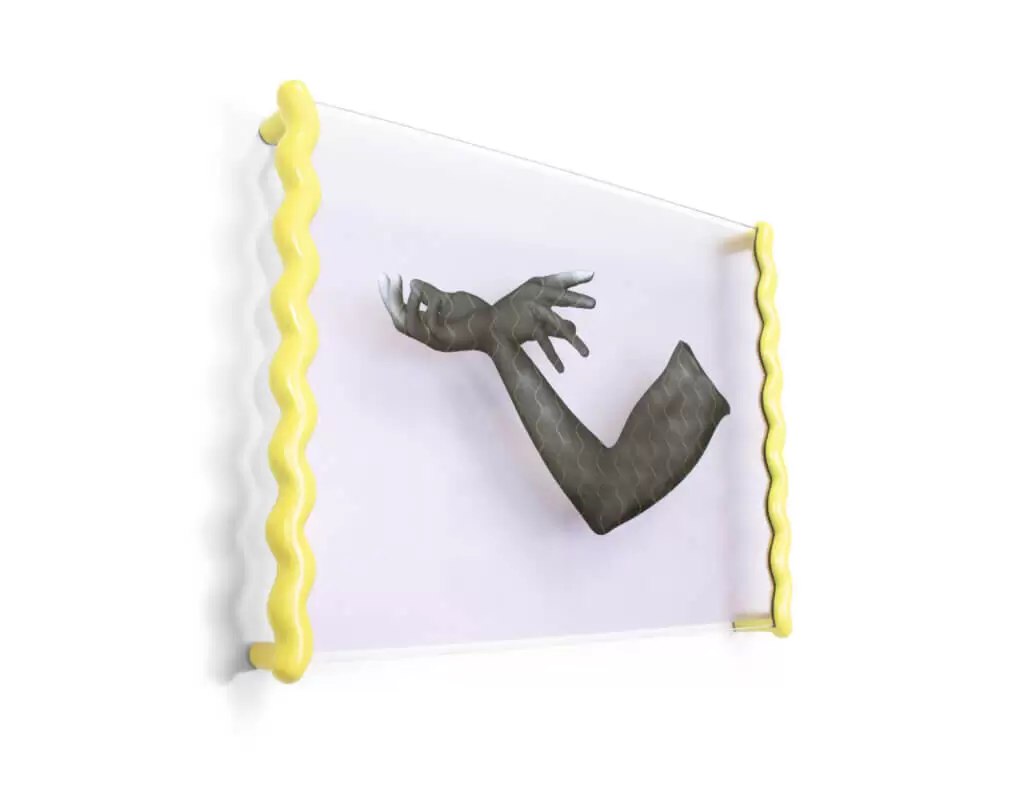Gracelee Lawrence often talks about her usage of fruit as a representational placeholder for human bodies, as “image and metaphor” in relation to fertility, sex, and the consumptive language that surrounds women’s bodies in particular.
By transforming female figures into fruit, Lawrence examines the patriarchal sculptural tradition and the often-eroticized malleability of a woman’s body in that tradition.
In Lawrence’s work, that tradition is confronted by the reality of form and objectification. Her 2016 remake of sculptor Charles Umlauf’s Reclining Nude—a creation of foam, powder coated steel, epoxy, plastic, pump, concrete—shows a double-crowned powder blue pineapple referencing the historical connotations of the fruit as exotic, commodified, colonized goods.

The first thought behind an object can come from many unexpected places, and I try to stay open and receptive to potential sources. It’s a mindset, not a formula.
Gracelee Lawrence
Using fruit as placeholders for sexualized bodies (such as in her pear-towered Summerhead fountain), Lawrence almost sets us up to question the absurdity of the original in its contemporary rendition.
The transfigurative nature of Lawrence’s craft is vital to her work, whether that be through analogue printing or the interaction between her ideas, perceptions of the traditionally male gaze, and videos, sculptures; illustrations on paper.
The time spent in her art-making process is just as important as the product. In her 2017 “When Watched” exhibition at Bangkok’s Bridge Art SpaceLawrence created poems on stairways translated between Thai and English via Google Translate, colossal sculptures, and drawn spatial maps signifying interactions between people—a telling of translation and perceived notions of interconnectedness through technology and the spaces our bodies occupy.
Q: First thing’s first, why do you do what you do?
Gracelee Lawrence: I have always been drawn to the inescapable actuality of the physical world and yet also fascinated by the shimmering, slippery expanse of digital reality. My work falls into the space between the two, relying equally on digital fabrication and hand augmentation to become whole, much as most of our 21st-century lives are made from an entwining of digital and physical information that is impossible to disentangle.
The concerns of the digital/physical divide parallel my other line of interest in the ways in which female-identified bodies have historically been fragmented and objectified in their comparison to commodities, and more specifically fruit and produce. This has recently evolved into the idea of biocyborgism, which I’ll dig into a little later on.

Q: What is your inspiration?
Gracelee Lawrence: It could come from a joke, a gesture, the way a vegetable looks as it’s being peeled, fruit propped on my table, or a line of text—essentially whatever may aid in the completion of an idea. The first thought behind an object can come from many unexpected places, and I try to stay open and receptive to potential sources. It’s a mindset, not a formula.
Q: What is your creative process when you’re creating?
Gracelee Lawrence: These objects are vessels of emotion. The idea often comes quickly, once I give it space to inhabit. Once I have an outline of the object—a quick pencil sketch of its formal qualities, purpose, and conceptual structure—I’ll begin the digital buildout. This usually involves some combination of 3D scanning my body, collecting 3D files made by others, and building my own components in digital space.

This diversity of origin is important to the conceptual structure as some components travel from physical to digital reality, some are created fully in digital space, and some borrowed from other makers. This parallels the complicated interweaving of our digital and physical realities.
The next phase is in the digital fabrication with my 3D printers—the object as a whole will be split into segments and printed in components, and then combined, skinned, and finished by hand in the addition of details and gestural qualities. The time spent with the objects in physical reality is incredibly important as they speak differently in physical space than the digital.
Q: Which is your preferred surface for working on?
Gracelee Lawrence: 3D printing is my preferred material and digital rendering is the method of preparation. In the course of making my larger work, the rendering and printing stage will only be about 1/2 of the overall process, but it provides a fleshed-out skeleton for the reactive physical choices to be made.
Q: What would you say is an integral part of the work of an artist?
Gracelee Lawrence: In my world, sensitivity is one of the most important characteristics of an artist. The artists I admire have an incredible ability to carefully assess and reimagine the world in a speculative fashion, blending reality with potential.

Q: What is the reason behind your use of foods in your works?
Gracelee Lawrence: I’ve long been interested in the intrinsic humor, historical complications, and cross-cultural meaning of fruit and foods. Fruit, in particular, has long symbolized an idealized form of sustenance, nourishing through visual and sensual satisfaction. Botanically speaking, a fruit is a seed-bearing organism that develops from the ovary of a flowering plant. Fruit is both erotic and humorous by nature, at the core of which exists the body.
More specifically: torsos are sorted into apple or pear shapes. Fruit is used as a representation for the size of a tumor. It is used as a metaphor for sexual experiences and sexualized body parts: bananas in phallic jokes, popping the cherry for the loss of virginity, breasts as melons, peaches to posteriors.
Pregnant women often take weekly pictures of their midsections with pieces of produce equivalent in size to their growing fetus. There is a reciprocation of language around bodies and plants: they are both pruned, grafted, sculpted, consumed. Both ripen and decay.

Q: How do you know when a piece is finished?
Gracelee Lawrence: In much of my work I’m aiming for a particular formal goal once the conceptual base has been built. This is most often capped with a final surface coat of paint, making for a clear end of the processes. The conceptual end goal happens very early on, and the majority of the physical building is working towards that goal.

Q: What is your favourite piece from your collection?
Gracelee Lawrence: The piece that I’m currently besotted with is Special Hungers, two arching pea pods morphing into a pair of fingers capped with beautifully manicured fingernails. I rarely keep any of my work in my own space, but I have a 9” lilac Special Hungers in my living room. I love the sensuality, humor, and formal qualities of the object and can’t wait to see it at the full 4-foot scale!
Q: How did you feel when you did your first solo exhibition?
Gracelee Lawrence: My very first solo exhibition was at a really wonderful community art space in Durham, North Carolina the year after I finished my bachelor’s degree. It was not a high-stakes show by any means, but I poured my heart into the work and filled the entire space with the colourful geometric steel abstractions I was making at the time. I was thrilled to have a space, any space, to show my work and start a conversation.
Q: What is the most rewarding thing for you about being a part of the art industry?
Gracelee Lawrence: My community of artists, curators, and thinkers are incredibly important to me. The commercial aspects of the art world can be disheartening, insular, and frustratingly exclusive, but having a strong community of artists makes the difficulties manageable. And, in this time of great changes in the world, artists are on the front lines to shift exclusionary systems and make our world, and thus the art world, a more equitable place.

Q: Is there anything that worries you about how social media is affecting the promotion of artists?
Gracelee Lawrence: It can be difficult to maintain a clear sense of purpose and focus when art making and social media collide. The trap of making work that looks good on the platform or is lauded in that context can be too powerful, or it may be hard to determine when accolades are used as overly strong guideposts in future work.
On the other hand, social media and particularly Instagram are wonderful connectors within the greater art community and have certainly given me a great feeling of kinship when I am physically distant from my community. This has become particularly poignant in 2020 due to pandemic isolation, when we can’t meet up for openings, studio visits, etc. Social media is a double-edged sword and must be used judiciously.

Q: Do you have any advice for artists on how to manage their social media image? Or does it even need managing?
Gracelee Lawrence: It certainly needs managing, as it is a non-negotiable piece of our current reality. I have friends and peers who opt not to use social media but concurrently cede both the benefits and downsides. Like it or not, social media is how many artists are found, how their work is disseminated, and how shows are publicized.
It operates as a place for interested parties to see work being made in that very moment and connect directly to the artist. It is also a place where lasting connections can be made—I first met some of my closest artist friends on Instagram!
Q: Do you have any advice for artists starting out and don’t know where to begin?
Gracelee Lawrence: The only thing is to DO (please see the letter from Sol Lewitt to Eva Hesse). When I was first beginning my journey as a young artist I took any opportunity, followed every line of thought or material, and waded into the unknown to find my edges. Finding an open headspace for ideas to converge is my best advice, but it is often the most difficult task of all.
Q: What would you say is the best way of getting your art noticed in the Age of the Internet?
Gracelee Lawrence: The most important thing is to make the work that needs to be made, not pandering to the Internet. Finding your community is the most important thing.
Q: Are there any places where you feel art and technology really shouldn’t overlap?
Gracelee Lawrence: I don’t think that there should be any limitations—we’re still relatively early in our collective understanding of the ways in which art and technology can intersect and those boundaries should continue to be probed and explored.
https://www.instagram.com/gleeleelawlee/
©2020 Gracelee Lawrence




